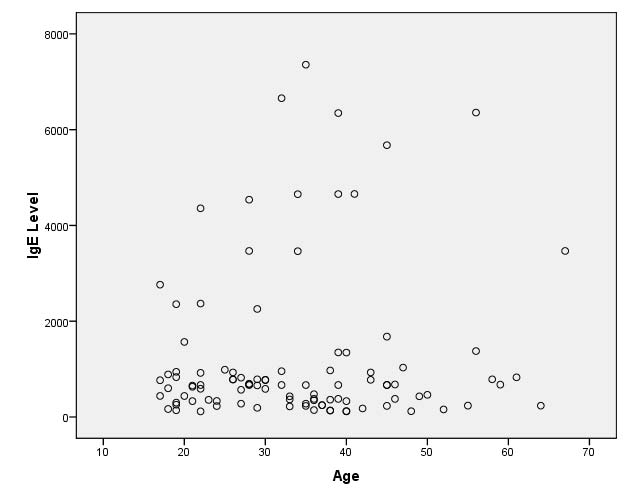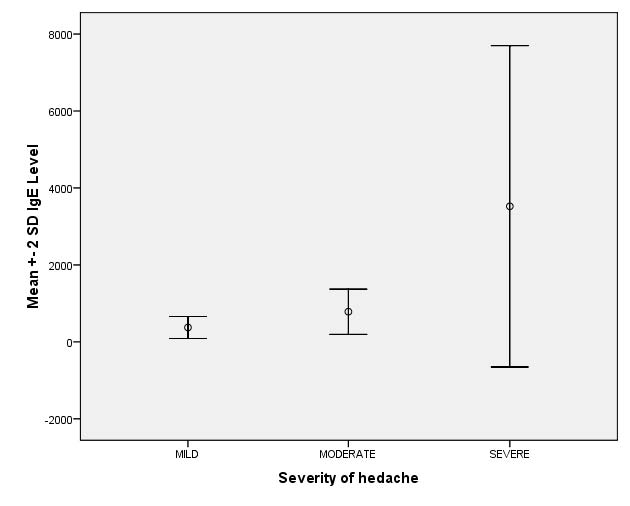Role of Gender and Serum Immunoglobulin E (IGE) levels on Severity of Migraine
David Rosario1, George Pinto2
1 P.G. Resident, Department of Ear, Nose and Throat, Father Muller Medical College, Mangalore, Karnataka, India.
2 Professor and H.O.D., Department of Ear, Nose and Throat, Father Muller Medical College, Mangalore, Karnataka, India.
NAME, ADDRESS, E-MAIL ID OF THE CORRESPONDING AUTHOR: Dr. David Rosario, P.G. Resident, Department of Ear, Nose and Throat, Father Muller Medical College, Mangalore-575002, Karnataka, India.
Phone: +919844454406,
E-mail: davidrosario84@gmail.com
Introduction: Migraine headache is a common disorders. Several studies have reported that migraine headache is more common in patients with allergy.
Aim: Aim of this study was to determine if the allergic sensitization is associated with the prevalence, frequency, and disability of migraine headaches.
Materials and Methods: The study was conducted during the period August 2013. During this period 100 patients of either gender who were diagnosed with migraine were selected and total serum Immunoglobulin E (IGE) levels were estimated. Prevalence of migraine headache and degree of allergic sensitization was estimated in these patients. Severity of migraine was assessed using the MIDAS score.
Statistical Analysis : Descriptive tables were generated showing the demographic and clinical characteristics of participants stratified by age and sex. Differences between subject groups were assessed by chi-square test. Correlation between severity of migraine and IgE levels was calculated using Pearson correlation.
Results: A total of 100 patients with migraine who presented to the outpatient department where studied. Prevalence of migraine was found to be higher in females compared to males. At the younger age group IgE levels were higher. Patients with higher levels of IgE had more severe headaches compared to those with lower levels of IgE. Patients with higher levels of IgE required a longer duration of treatment compared to those with lower levels of IgE.
Conclusion: Prevalence of migraine is high among females. Younger age and female sex are other contributory factors as prevalence of migraine is higher in these groups. Degree of allergic sensitisation determines the severity and frequency of headaches in those whom allergic rhinitis is a risk factor as evidenced by higher levels of IgE.
Migraine,Allergic sensitisation
Introduction
Migraine headache is a common disorders. Several studies have reported that migraine headache is more common in patients with allergy. Atopy, which is the genetic predisposition to develop IgE antibodies to specific allergens, may be associated with increased frequency of migraine headache.
Other studies found that migraine headache improved or were eliminated altogether in patients that followed an elimination diet of common food allergens. However these studies have not correlated if degree of allergic sensitisation is associated with the severity of headaches in migraineurs. Thus, limited data exist to support the contention that exposure to allergens increases the frequency of migraine attacks in atopic migraineurs.
Immunotherapy can induce tolerance to specific allergens by altering cytokine responses of T-helper cells and through induction of Immunoglobulin G (IgG) and Immunoglobulin A (IgA) antibodies that block the binding of IgE to mast cells. Thereby providing an alternative approach in treatment of migraine in patients with allergy.
Aim of this study is to determine if the sex difference and allergic sensitization is associated with the prevalence, frequency, and disability of migraine headache.
Materials and Methods
Source of the Data
The present study was conducted in the Department of Otorhinolaryngology, Father Muller Medical College, Mangalore, India.
Methods of Collection of Data
The study was conducted in the month of August 2013. During this period 100 patients of either gender who were diagnosed with migraine were selected and total serum IgE level was estimated.
We hypothized that individuals with greater degrees of allergic sensitization (increased IgE levels in serum) would be more likely to experience migraine headaches and that their attacks would be more frequent and disabling than those with lower degrees of atopy.
Inclusion criteria
Ages 18-65 years;
Ability to give informed consent;
A diagnosis of migraine
Exclusion criteria
Other primary headaches like tension type of headache and cluster headaches.
Past history of secondary headache disorders such as a brain aneurysm or brain tumor;
Significant chronic medical illnesses such as malignancy, chronic renal failure, tuberculosis, lupus, rheumatoid arthritis, sarcoidosis, hypereosinophilic syndrome, Wegener’s granulomatosis, Churg-Strauss vasculitis, and polyarteritis nodosum;
Pregnancy.
Procedure
All participants were asked if they had experienced headaches in the last year unrelated to respiratory infection, head trauma or hangover. If they give an affirmative response to the above question then a structured verbal headache interview was administered to determine the characteristics of each headache type.
All classifiable headache diagnoses had met strict criteria of the International Classification of Headache Disorders-II-2004 [1]. Migraine headache was defined as ICHD-2 diagnoses of 1.1-1.5.
Severity of headache was assessed based on MIDAS score [2].
Statistical Analysis
Descriptive tables were generated showing the demographic and clinical characteristics of participants by migraineurs stratified by age and sex. Differences between subject groups were assessed by chi-square test. Correlation between severity of migraine and IgE levels was calculated using Pearson correlation.
Study was conducted after obtaining ethical clearance from concerned authorities.
Results
In this study out 100 patients 74 were females and 26 were males. In this study majority patients were in the age group of 18 to 28 years.
In this study as depicted in the above table and graph there was a negative correlation between age and IgE levels with r=-0.092, which implies that at the younger age group IgE levels were higher [Table/Fig-1,2].
Correlation between age and IgE levels
Negative correlation between IgE level and age, r= -0.092.
| Correlations | IgE | AGE |
|---|
| IgE | Pearson Correlation | 1 | .092 |
| Sig. (2-tailed) | | .362 |
| N | 100 | 100 |
| age | Pearson Correlation | .092 | 1 |
| Sig. (2-tailed) | .362 | |
| N | 100 | 100 |
Correlation between age and IgE levels

In this study patients with higher levels of IgE (mean 3,523) had more severe headaches compared to those with lower levels of IgE [Table/Fig-3,4].
Severity of hedache and IgE level
| Severity | IgE (Mean, SD) |
|---|
| Mild | 373.75 (142.69) |
| Moderate | 784.54 (293.97) |
| Severe | 3,523 (2,088.03) |
Correlation between severity of headache and IgE levels

Discussion
This is one of the rare studies which helps to determine if the degree of allergic sensitization are associated with the prevalence, frequency and disability of headache in patients with migraine. Past studies have assumed that the effect of allergy on migraine headache is uniform across all atopic patients [3,4]. Our results suggest that the associations between allergy and migraine headache may depend upon the degree of allergic sensitization, IgE levels, sex and patient ge as shown by other studies done by Scarupa MD et al., and Saberi A et al., [5,6].
In this study out 100 patients 74% were females and 26% were males. A study done by Russell MB et al., [7] showed that there was significant preponderance among females. Also in our study we found that majority patients were in the age group of 18 to 28 years. In a study conducted by Ralph Mösges, [8] Stewart WF et al., [9] age prevalence of migraine was maximum in age group of 15 to 30 years which is comparable to this study.
In this study there was a negative correlation between age and IgE levels with r=-0.092, which implies that at the younger age group IgE levels were higher. In a study conducted by Omenaas E et al., [10] the mean IgE levels where higher in younger age groups which is similar to this study. Also in this study we observed that patients with higher levels of IgE (mean 3,523) had more severe headaches compared to those with lower levels of IgE (mean 373.75). However as this study was first of its kind where IgE levels were compared with severity of headaches in patients with migraine no supportive data is currently available to compare our results.
Conclusion
Younger age and female sex are contributory factors as prevalence of both allergic rhinitis and migraine is higher in these groups.Degree of allergic sensitisation determines the severity and frequency of headaches in those whom allergy is a risk factor as evidenced by higher levels of IgE.
[1]. Headache Classification Subcommittee of the International Headache SocietyThe International Classification of Headache Disorders (2nd Edition) Cephalalgia 2004 24(1):24-36. [Google Scholar]
[2]. Stewart WF, Development and testing of the Migraine Disability Assessment (MIDAS) Questionnaire to assess headache-related disability Neurology 2001 56:S20-8. [Google Scholar]
[3]. Larry Borish, Bradley Chipps, Yamo Deniz, Gujrathi Sheila, Zheng Beiyao, Dolan Chantal M, Total serum IgE levels in a large cohort of patients with severe or difficult to treat asthma Annals of Allergy, Asthma and Immunology 2005 95(3):247-53. [Google Scholar]
[4]. Ku M, Silverman B, Prifti N, Ying W, Persaud Y, Schneider A, Prevalence of migraine headaches in patients with allergic rhinitis Ann Allergy Asthma Immunol 2006 97(2):226-30. [Google Scholar]
[5]. Scarupa MD, Economides A, White MV, Kaliner MA, Rhinitis and rhinologic headaches Allergy Asthma Proc 2004 25(2):101-5. [Google Scholar]
[6]. Saberi A, Nemati S, Shakib RJ, Kazemnejad E, Maleki M, Association between allergic rhinitis and migraine Journal of Research in Medical Sciences 2012 17(6):508-12. [Google Scholar]
[7]. Russell MB, Rasmussen BK, Thorvaldsen P, Olesen J, Prevelance and sex ratio of subtypes of migraine Int J Epidemiol 1995 24(3):612-8. [Google Scholar]
[8]. Prof. Dr. med. Ralph Mösges (University of Cologne) German survey 1995 [Google Scholar]
[9]. Stewart WF, Wood C, Reed ML, Roy J, Lipton RB, Cumulative lifetime migraine incidence in women and men Cephalalgia 2008 28(11):1170-8. [Google Scholar]
[10]. Omenaas E, Bakke P, Elsayed S, Hanoa Gulsvik A, Total and specific serum IgE levels in adults: relationship to sex, age and environmental factors Clin Exp Allergy 1994 24(6):530-9. [Google Scholar]